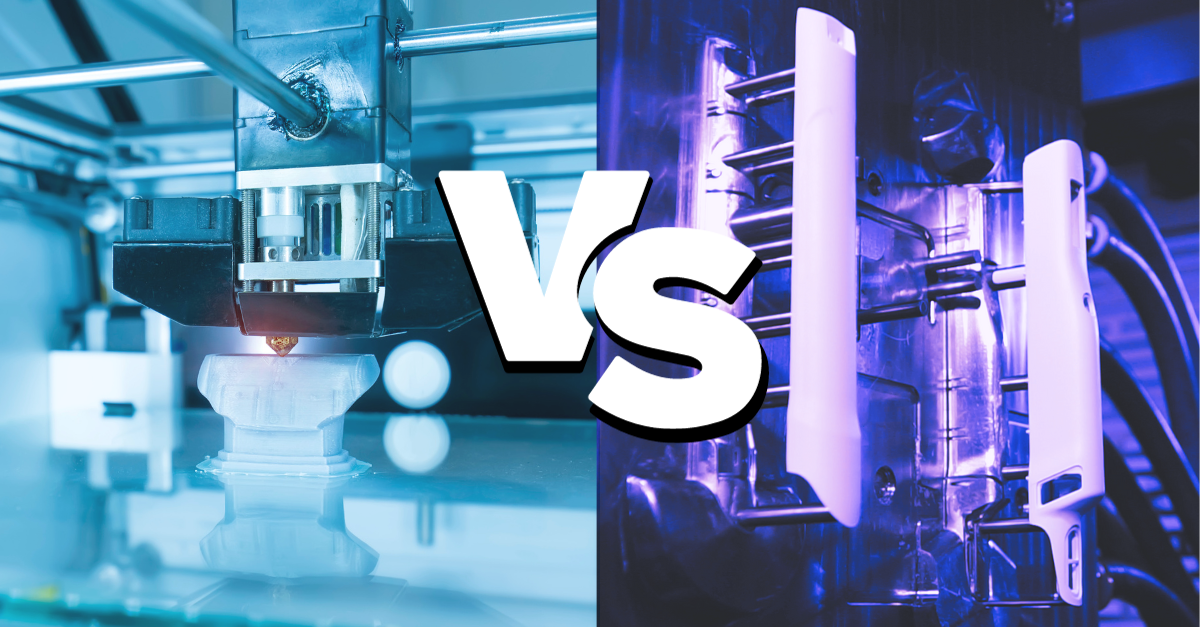Many manufacturers compare 3D printing vs. injection molding to determine the best method for manufacturing their plastic products. Undoubtedly, 3D printing has unique benefits, but that doesn’t mean it will replace the injection molding processes. Manufacturers will benefit from understanding the limitations and advantages of these two technologies before making any decisions.
The Basics of 3D Printing Technology
3D printing is an additive manufacturing technology. This means that material is added to create a part or product rather than removed, like in milling and machining. While injection molding machines rely on molds to shape the material they inject, 3D printing lays down material layer by layer through a nozzle.
During the 3D printing process, a computer guides the nozzle as it puts down each layer, similar to how a CNC mill is controlled. Instructions are predetermined and generated from a 3D model using slicer software. The part is built up layer by layer, with new material adhering to the layer below. After hundreds or even thousands of layers, the finished product is ready.
Limitations of 3D Printing Processes
While 3D printing provides many benefits, its limitations make it unsuitable for many manufacturing applications. Production volume is one area where 3D printing falls behind other methods. As mentioned above, the 3D printer nozzle lays down many layers of material to create a part, both for the contour of the layer and the infill. With so many layers required, this process is significantly slower than injection molding.
3D printing costs are often raised by post-processing requirements that can incur additional costs. Even high-quality 3D printers will have visible lines showing the layers rather than a smooth finish and have practical limitations regarding size, as parts must fit on the print bed.
Advantages of 3D Printing Services
Regarding 3D printing vs. injection molding costs and turnaround time for projects of various scales, 3D printing can be a better choice for some applications. Manufacturers often take advantage of 3D printing services in these areas.
Testing Part Designs
Compared to injection molding, 3D printing provides much more versatility when testing part designs. A 3D model can be ready for printing quickly, and changes can be made and implemented after each test.
While injection molding would require creating new molds every time, 3D printing only requires the preparation of a digital file. Manufacturers have the design freedom to create many variants of parts to carry out testing.
With 3D printing, manufacturers can create prototypes in minutes, hours, or days, depending on the size of the part in question. They can verify complex designs' geometry, integrity, and assembly before moving on to mass production.
Customization
In injection molding, a mold creates a large volume of identical parts. With 3D printing, every piece can be different. Each order can be customized.
This feature is why 3D printing is used in the medical industry, where dental products, artificial valves, and other items must be custom-made for every patient.
The Power of Injection Molding
Injection molding is among the most widely used plastics manufacturing technologies, with injection molding companies worldwide creating products for many industries. Even with the availability of new technologies, it remains the best choice in many applications.
Limitations of Injection Molding Operations
While versatile, injection molding isn’t always the best choice for every part or product. Unique molds must be created for every new component, which leads to higher lead times and initial costs. These aren’t significant concerns in mass production but can affect viability for smaller production runs.
The injection molding process also has specific product design restraints. Parts must be designed to be removed from molds without breaking. Intricate designs or those with certain angles may not be suitable for injection molding.
Key Advantages of Injection Molding Over 3D Printing
Injection molding has key advantages that make it suitable for many manufacturing applications and is widely used in mass production.
Scalability and High-Volume Production Capabilities
Mass production is where injection molding truly shines. A part that might take a 3D printer hours takes an injection molding machine just seconds to make. Molds can also be designed to create multiple sets simultaneously.
Injection molding is also highly scalable. The production of additional molds can increase overall capacity to enable higher volume while increasing capacity in 3D printing requires purchasing and operating extra printers.
Material Variety and Performance Consistency
Injection molding can use a broader range of materials to obtain the qualities needed in a finished product. One area where this is particularly notable is strength.
Injecting material in a single layer provides additional strength. 3D printing can also use various materials, but the maximum achievable temperature limits material selection.
Cost Efficiency and Long-Term Viability
Injection molding has significantly lower production costs than 3D printing when considering equipment investment and footprint.
Material costs are also lower in injection molding. 3D printing requires extruded filament, while injection molding machines use lower-cost pellets and regrind. These reduced costs make injection molding a more viable option for a successful manufacturing operation in most cases.
Make the Right Choice for Your Project With an Injection Molding Expert
Not sure which production method is right for your product? The experts at Crescent Industries can help you make the right choice. We provide a wide range of injection molding services. Contact us today to find a solution that works for your finished product and delivers the cost efficiency your operations need.


